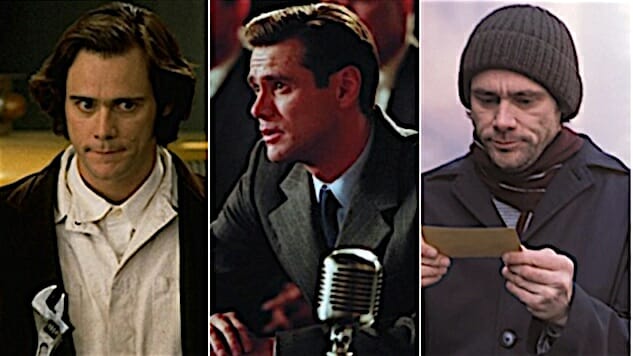
Growing into my teenage years during the first half of the ’90s, I distinctly remember Jim Carrey’s sudden rise from small roles in movies and his supporting part in In Living Color to mega stardom that turned him into the highest paid actor in Hollywood within the course of two years. As is often the case with comedians who experience a surge of massive popularity, Carry was immediately typecast, in his case as the rubber-faced ball of nutso energy. Even during the dependably par-for-the-course years of Ace Ventura and The Mask, it was obvious that someone with such unbridled creativity would not be stuck doing the same schtick for long. Before the ’90s even ended, Carrey reestablished himself just as much of a dramatic power player as a comedic trailblazer. In honor of Carrey’s long-awaited return to dramatic acting in the somber Polish crime drama Dark Crimes, let’s rank his top five dramatic performances.
5.The Hermit in The Bad Batch (2016)
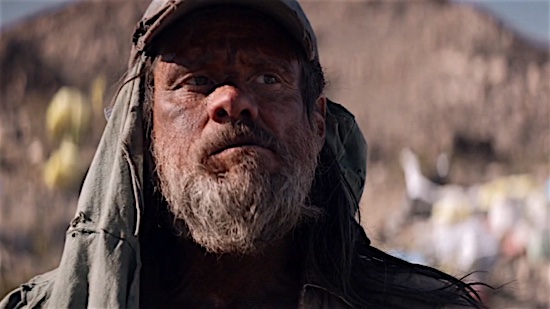
Writer/director’s Ana Lily Amirpour’s ambitious but scattershot post-apocalyptic allegory about our insane current culture is downright allergic to subtlety. The protagonist has a tattoo on her arm that reads “Fear,” and the arm gets cut off at the beginning of the story. Get it? GET IT!? That’s why it’s so refreshing that Carrey’s borderline unrecognizable supporting presence as a filthy, mute hermit who lives for pencil sketching his subjects, an unusual hobby in the middle of a cannibal-ridden dystopia, refrains from giving the audience any clear exposition about his motivations and goals within the narrative. There’s certainly an interesting past that comes with this mysterious character, and Carrey manages to communicate so much inner pain and disdain for his surroundings with the simplest of facial expressions and tics. For such a commendable exercise in restrained emotional connection with the audience to come from the once-rubber-faced, manic comedian exhibits the depth of Carrey’s range.
4. Peter Appleton in The Majestic (2001)
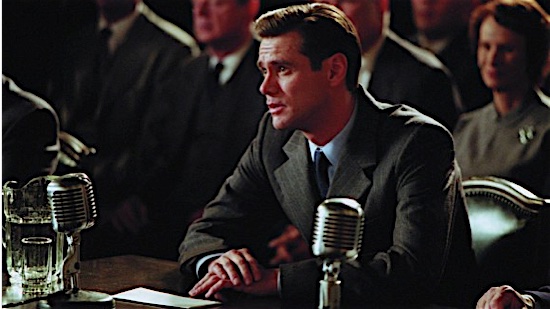
With The Majestic, director Frank Darabont and star Jim Carrey wanted to deliver a wholesome Frank Capra send-off to counter the cynical nature of modern entertainment. For their admirable efforts, they were rewarded with the biggest flop of both of their careers. For the twenty people who still remember The Majestic’s existence, it’s criticized as being too maudlin and simplistic for the modern audience. For those who pay closer attention to Darabont and Carrey’s approach to the story, that appears to be the point in the first place. The film begins and ends with cynical producers (voiced by Hollywood power players of the time, in case you didn’t get the point) pitching ideas to needlessly sensationalize a tender drama. As evidenced by his recent spiritual musings, there’s a part of Carrey that yearns for a peaceful and wholesome connection between people, and The Majestic provides the perfect opportunity to communicate that through his straight-faced take on a self-obsessed writer who suffers from amnesia and uses his new life to give new hope and purpose to a downtrodden small town. The relatability-with-the-common-man factor might not be up at Jimmy Stewart levels, but he still pulls it off admirably.
3. Truman Burbank in The Truman Show (1998)
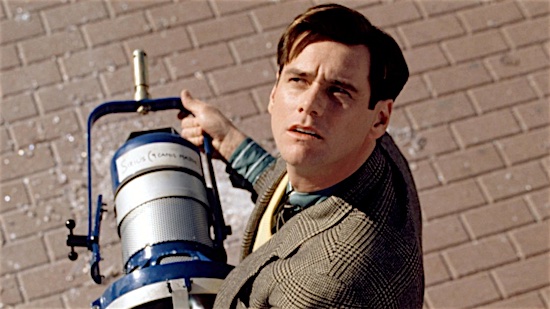
Around the time of The Truman Show’s release, Jim Carrey’s highly publicized first foray into a dramatic leading role, I remember critics commenting that his role as a man who’s unknowingly trapped inside a 24/7 reality show about his artificial life should be a bit of a layup for Carrey, since Peter Weir’s film had many comedic touches, therefore presenting at least a tone that’s familiar to his career. With its clear satirical touches on modern media, The Truman Show was certainly more of a dramedy rather than an all-out tragedy, but that’s also beside the point. Instead of the eccentric motormouth constantly at the center of attention, chewing scenery like a starved wolverine, Carrey was now tasked with playing the calm, collected, and yes, boring straight man who gradually experiences the reality around him crumble into pieces. It was time for Carrey to let his crazy surroundings and supporting characters bring the quirk, which presented him with a challenge to present a restrained everyman performance, quite a departure from the Ace Ventura days. If we don’t believe in Truman’s common humanity, the whole narrative falters, and Carrey pulls it off with flying colors.
2. Joel Barish in Eternal Sunshine of the Spotless Mind (2004)

There’s a subversive energy to Carrey’s comedy output, willing to push the envelope far enough to confuse the audience as to whether or not he’s communicating a witless clown or a deeply disturbed tragic figure. Director Michel Gondry taps into that energy as he takes full advantage of the polar emotional states that inhabit Carrey’s personality. As a romantically depressed and confused man who first wants to erase all memories of his ex-girlfriend (Kate Winslet), then tries desperately to save those memories during a manic race against time, Carrey enjoys toying with the extreme emotional states of the character, somehow managing to construct a universal conduit for millions of audience members who have suffered similar heartache.
1. Andy Kaufman in Man on the Moon (1999)
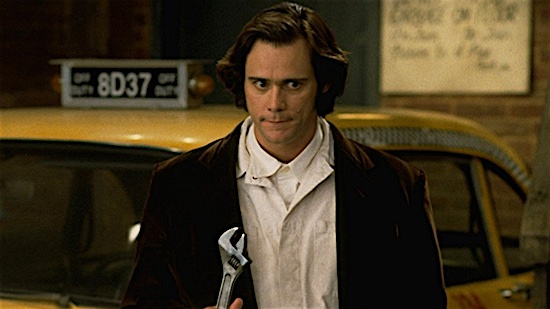
Even before finding out just how obsessed Carrey was with capturing his idol Andy Kaufman’s essence, as evidenced by the disturbingly detailed Netflix documentary Jim & Andy, it’s easy to understand why Carrey gave it his all to capture Kaufman in Milos Forman’s underrated biopic about the notorious comedy trickster. Both Carrey and Kaufman sought to extract some form of unexpected reactions from their audience, with the genre or tone of that reaction, comedic, dramatic, avant-garde, alternative, etc., an afterthought, if even that. It’s a shameless cliché to say this, but it fits here: Carrey gets lost in the role in Man on the Moon, where the line between Carrey and Kaufman becomes indistinguishably blurred. As evidenced by the documentary, the production was fraught with frustrations as Carrey refused to break character and in true Andy Kaufman fashion, favored disruption via reaching new levels of performance art over the cohesion of the production, but the end result shows a clear success in Carrey’s mission to truly capture Kaufman’s essence.
Oktay Ege Kozak is a screenwriter, script coach and film critic. He lives near Portland, Ore., with his wife, daughter and two King Charles Spaniels.